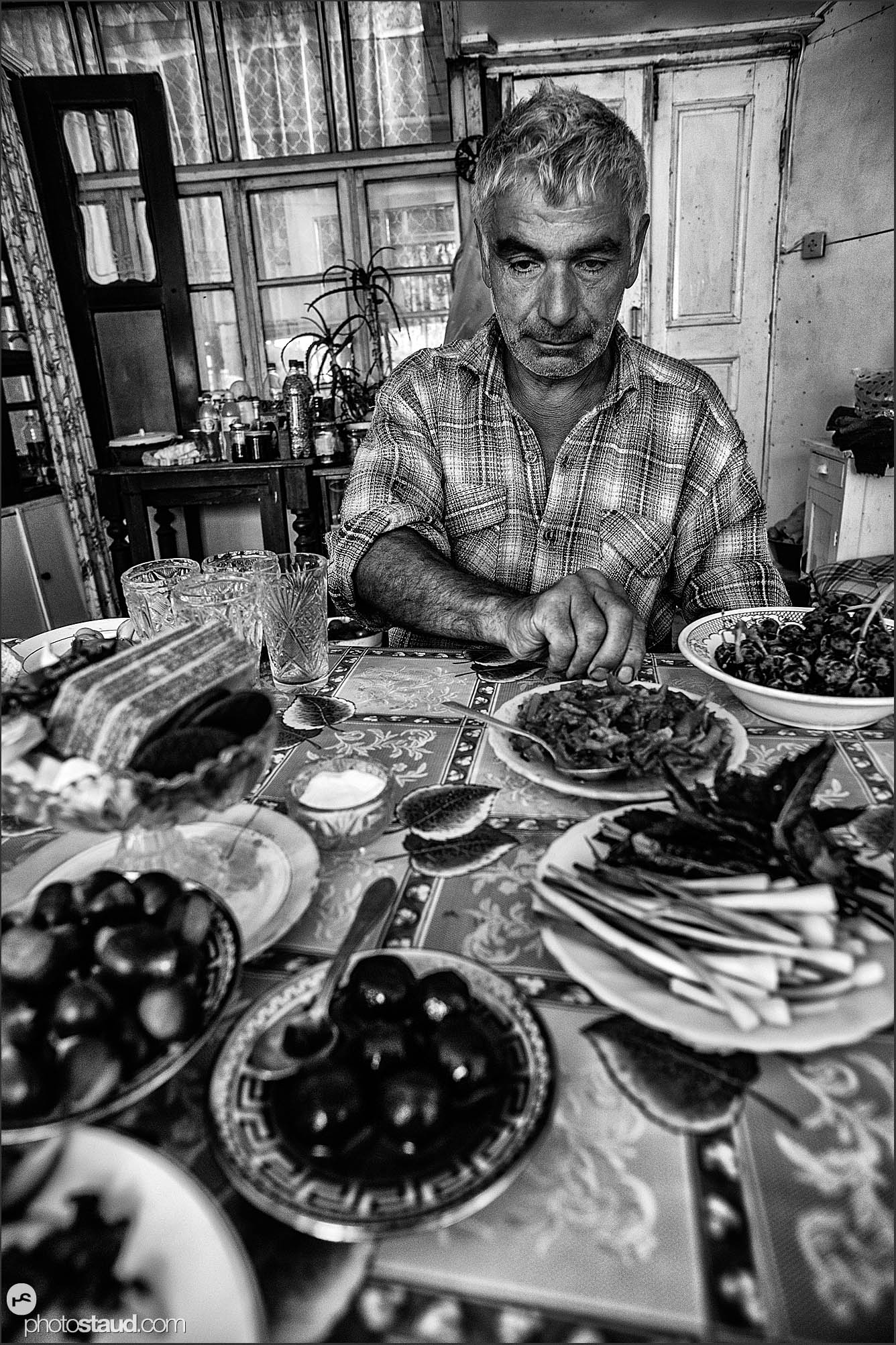Second part of a travelogue from Nagorno-Karabakh by Frantisek Staud
Text and photographs © by the author.
For the first part, click here.
In the evening I continue to the largest ghost town in the world, Agdam – a symbol of suffering and hatred of two nations. All houses are in ruins, only one mosque was spared the fury. From the top of its minaret I stare at the horrifying consequences of the conflict, reminiscent of nuclear disaster. While cruising the dusty roads of the once vibrant city I cannot resist a mix of sadness, fear and despair. Before the war, fifty thousand people lived here – today, the town is all forsaken and only abandoned dogs cross my path here and there. After nightfall I notice glimmering light in one building. From its courtyard, hidden among sacks of fruit, three men observe me suspiciously. Ernest, Boris and Michael are processing their fertile harvests of pomegranates and, of course, drinking vodka. They do not hesitate too long to invite me in, and between many stakans (I told you that driving a car is not an excuse here, didn´t I?) they keep telling their stories.

On the way to the south I pass through several villages to be assured, again and again, about unbelievable hospitality of the locals. I am offered countless invitations to households, given more shashlik I can digest and more vodka I can metabolize. Raya and Volodya Gryginov, both in their seventies, invite me home for coffee and lunch as soon as I get out of the car in the village of Karmir Shuka. Fractured iron gate in front of their house is pierced with bullets from automatic weapons. Volodya shows me several places in his garden where the grenades fell. He tells me of his sons and daughter, all of whom fought in the nearby mountains; they were 17 years old then. “Next time you come here, enter without knocking, the door is never locked,” he sums up in one sentence the mentality of the villagers.

Villages are often riddled and rarely maintained; the remains are gradually overgrown by vegetation. Monuments along the roads are the only modern structures I can see. In the village of Togh a boy is waving at me to invite me for a lunch with his family – my second lunch in a few hours. To decline would have been extremely impolite so I enter the house, one of the few that has got a roof. Vera, the boy´s mom, had prepared lunch as if she expected me – shashlik, halva, baklava, cheese, jam and of course vodka – everything is of domestic production. Many people here are relying on themselves – it is far to a store and there is often little or no money to be spent. Through the window, Vera points to the ruins of a neighboring house; an Azerbaijan family used to live there. And they lived there in peace; as neighbors they celebrated, together they went to church or to the pub. But the war changed everything. All Azerbaijan villagers disappeared, leaving only ruined houses behind.

I continue to the north, along the Azeri border, passing through Askeran, Tigranakert, Martakert. Twenty years after the conflict the traces of war are visible everywhere: the overturned tank torsos, destroyed houses, military trenches and empty shells in the fields. I’m still within sight of the hot line. In the streets I see more uniformed than civilians. As soon as I step out of the car in Martakert to make a few images of shattered cultural center a uniformed soldier approaches me with a never-ending series of questions: “Why are you taking pictures?” “What for?” Why? When? What? Luckily he becomes interested in a little compass attached to my pants. I decide to give it to him as a little present to save the photos on my cards, swiftly get back in the car and leave.
Behind the village on the road I meet Stephen, an evident homeless. I offer him a lift, he pays back by telling stories. Stephen gives me the insight from the other side of the border. As an Armenian he lived in Azerbaijan, from where he was exiled during the war. He tells me how he fought for freedom of the Nagorno-Karabakh, had been wounded many times, but because he came from Azerbaijan, the government identified him as a potential terrorist. To this day, he did not get any apartment, nor pension; he lives in a retirement house and wanders around the village.

On my way back to Armenia through a mountain Sotka pass I taste what it means off-road driving in Nagorno-Karabakh. Asphalt is torn at first, then none at all. Just holes, mud, rocks, and in higher altitudes the first snow of this year. In the mountain saddle I step out of the car to pay farewell to Nagorno-Karabakh. The evening haze envelops the “Black Garden” in a white veil and softens the contours of the landscape. It occurs to me in that moment that it metaphorically symbolizes the perception of Nagorno-Karabakh by the outside world: no matter how beautiful, still hazy, fuzzy, and illegible.
Photo gallery of Nagorno-Karabakh:
1 thought on “In the mountains of the Black Garden (II)”